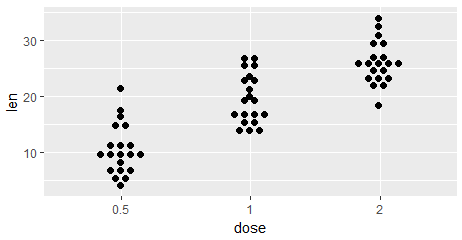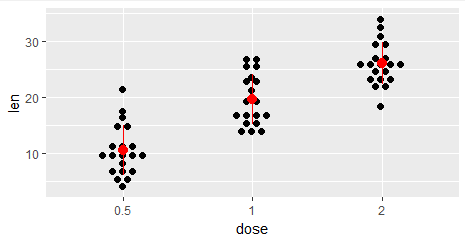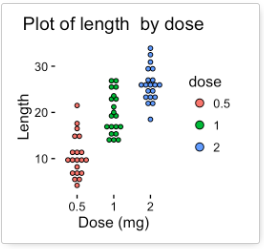ggplot2包中绘制点图的函数有两个:geom_point和 geom_dotplot,当使用geom_dotplot绘图时,point的形状是dot,不能改变点的形状,因此,geom_dotplot 叫做散点图(Scatter Plot),通过绘制点来呈现数据的分布,对点分箱的方法有两种:点密度(dot-density )和直方点(histodot)。当使用点密度分箱(bin)方式时,分箱的位置是由数据和binwidth决定的,会根据数据进行变化,但不会大于binwidth指定的宽度;当使用直方点分箱方式时,分箱有固定的位置和固定的宽度,就像由点构成的直方图(histogram)。
bin是分箱的意思,在统计学中,数据分箱是一种把多个连续值分割成多个区间的方法,每一个小区间叫做一个bin(bucket),这就意味着每个bin定义一个数值区间,连续值会落到相应的区间中。
对点进行分箱时,点的位置(Position adjustment)有多种调整方式:
- identity:不调整
- dodge:垂直方向不调整,只调整水平位置
- nudge:在一定的范围内调整水平和垂直位置
- jitter:抖动,当具有离散位置和相对较少的点数时,抖动很有用
- jitterdodge:同时jitter和 dodge
- stack:堆叠,
- fill:填充,用于条形图
每个位置调整都对应一个函数position_xxx()。
当沿着x轴进行分箱,并沿着y轴堆叠时,y轴上的数字没有意义。
当沿x轴进行分箱并沿y轴堆叠时,由于ggplot2的技术限制,y轴上的数字没有意义。 您可以隐藏y轴(如其中一个示例中所示),也可以手动缩放y轴以匹配点数。
使用geom_dotplot()函数来绘制点图:
geom_dotplot(mapping = NULL, data = NULL, position = "identity", ..., binwidth = NULL, binaxis = "x", method = "dotdensity", binpositions = "bygroup", stackdir = "up", stackratio = 1, dotsize = 1, stackgroups = FALSE, origin = NULL, right = TRUE, width = 0.9, drop = FALSE, na.rm = FALSE, show.legend = NA, inherit.aes = TRUE)
常用的参数注释:
- mapping:使用aes()来设置点图美学特征,参数x是因子,参数y是数值
- data:数据框对象
- position:位置调整(Position adjustment),默认值是identity,表示不调整位置。
- method:默认值是dotdensity(点密度分箱),或者histodot(直方点,固定的分箱宽度)
- binwidth:该参数用于调整分箱的宽度,该参数受到method参数的影响,如果method是dotdensity,那么binwidth指定分箱的最大宽度;如果method是histodot,那么binwidth指定分箱的固定宽度,默认值是数据范围(range of the data)的1/30。
- binaxis:沿着那个轴进行分箱,默认值是x
- stackdir:设置堆叠的方向,默认值是up,有效值是down、center、centerwhole和up。
- stackratio:点堆叠的密集程度,默认值是1,值越小,堆集越密集;
- dotsize:点的大小,相对于binwidth的直径,默认值是1。
使用ToothGrowth数据来绘制点图:
ToothGrowth$dose <- as.factor(ToothGrowth$dose)
一,绘制点图
绘制基本的点图
library(ggplot2) p <- ggplot(ToothGrowth, aes(x=dose, y=len)) + geom_dotplot(binaxis='y', stackdir='center', stackratio=1.5, dotsize=1.2)

二,添加汇总数据
向点图中添加汇总数据,使用ggplot2包中的函数
stat_summary(mapping = NULL, data = NULL, geom = "pointrange", position = "identity", ..., fun.data = NULL, fun.y = NULL, fun.ymax = NULL, fun.ymin = NULL, fun.args = list(), na.rm = FALSE, show.legend = NA, inherit.aes = TRUE)
常用参数注释:
- fun.data:指定一个函数(function),返回带有变量ymin,y和ymax的数据框 或者,指定三个单独的函数,分别向每个函数传递一个向量,分别返回一个数字,用于表示ymin、y和ymax:
- fun.y:
- fun.ymax:
- fun.ymin:
- fun.args=list():可选的参数,用于指定传递给fun.xxx函数的参数
1,向点图中增加均值和中位数
# dot plot with mean points p + stat_summary(fun.y=mean, geom="point", shape=18, size=3, color="red") # dot plot with median points p + stat_summary(fun.y=median, geom="point", shape=18, size=3, color="red")

2,向点图中增加点范围
fun.low.mean <- function(x){mean(x)-sd(x)}
fun.up.mean <- function(x){mean(x)+sd(x)}
ggplot(ToothGrowth, aes(x=dose, y=len)) +
geom_dotplot(binaxis='y', stackdir='center', stackratio=1.5, dotsize=1.2)+
stat_summary(fun.y = mean, fun.ymin = fun.low.mean, fun.ymax = fun.up.mean, colour = "red", size = 0.7)
3,使用fun.data向点图中增加点范围
data_summary <- function(x) { m <- mean(x) ymin <- m-sd(x) ymax <- m+sd(x) return(c(y=m,ymin=ymin,ymax=ymax)) } ggplot(ToothGrowth, aes(x=dose, y=len)) + geom_dotplot(binaxis='y', stackdir='center', stackratio=1.5, dotsize=1.2)+ stat_summary(fun.data = data_summary, colour = "red", size = 0.7)

三,按照分组改变点图的颜色
首先要对点图分组,这通过aes(fill=dose)来实现,然后,使用scale_fill_manual()来设置每个分组的颜色:
ggplot(ToothGrowth, aes(x=dose, y=len, fill=dose)) + geom_dotplot(binaxis='y', stackdir='center')+ scale_fill_manual(values=c("#999999", "#E69F00", "#56B4E9"))

四,添加点图的说明
通过theme函数向点图中增加说明,通过legend.position来控制说明的位置
ggplot(ToothGrowth, aes(x=dose, y=len, fill=dose)) + geom_dotplot(binaxis='y', stackdir='center')+ scale_fill_manual(values=c("#999999", "#E69F00", "#56B4E9"))+ theme(legend.position="top")

五,向点图中增加标题和轴的标签
通过labs()来添加标题和坐标轴的标签
ggplot(ToothGrowth, aes(x=dose, y=len, fill=dose)) + geom_dotplot(binaxis='y', stackdir='center')+ scale_fill_manual(values=c("#999999", "#E69F00", "#56B4E9"))+ labs(title="Plot of length by dose",x="Dose (mg)", y = "Length")+ theme_classic()

参考文档:
ggplot2 dot plot : Quick start guide - R software and data visualization